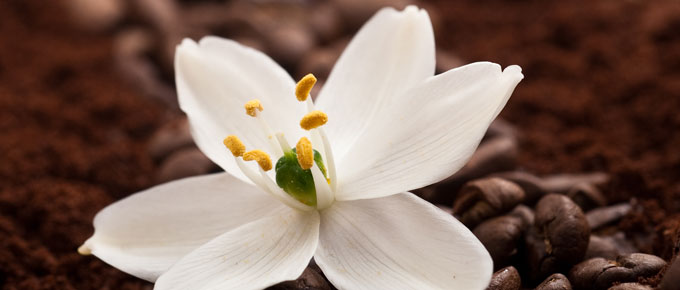GLOSSARY
To improve one’s knowledge of the world of coffee…
ARABICA
The Latin and botanical name is Coffea arabica Linné and this species of coffee tree is the most commonly cultivated in the world. It comprises 200 different varieties including the well-known Bourbon, Moka, Typica, pointed Bourbon and Maragogype.
AROMAS
The aromas of coffee are released only under the effect of heat, when the beans are roasted. A complex phenomenon of mutations between proteins, acids and carbohydrates gives rise to the numerous aromas (up to more than one thousand different aromatic components).
These aromatic notes belong to very different aromatic families, such as empyreumatic, floral, woody, spicy, fruity; balsam etc. These notes are fragile and volatile and to preserve them the coffee must be packed very quickly after the roasting process, preferably in a tin (which is the best way of preserving the aromas).
GREEN COFFEE
Green coffee is actually the coffee beans extracted from the fruit of the coffee bush – called berries – after harvesting. The coffee grains have no smell or taste and their size varies according to the species and variety.
COFFEE PLANTATION
Also called a Fazenda in Brazil.
CAFFEINE
This is a chemical substance that occurs naturally in coffee in varying proportions (0.5 to 4 % on average). The caffeine content of an Arabica varies, on average from 0.5 to 1.5 % whereas robusta generally contains between 1.5 and 4 %.
Caffeine is a natural stimulant and it is sometimes prescribed in certain therapeutic treatments because of its many properties. It can be used to treat migraine and it is also included in certain slimming creams.
BERRY
This is the fruit of the coffee tree. It is also called a drupe. Generally, each berry contains two coffee grains but occasionally only one is found – and this is called a caracole. Very rarely, one finds three beans in the same berry.
BODY
This describes the strength and power of a coffee. The term also includes the thickness and consistency of the nectar.
VINTAGE
As is the case for wine, this describes the exact area where the coffee grows. There are more than 400 throughout the world: the legendary Blue Mountain in Jamaica, Farfell Estate in Zimbabwe, Moka Sidamo in Ethiopia and Kona Lei in Hawaii are among the most prestigious. A huge range of vintages for a huge range of tastes !
DECOCTION
This is undoubtedly the oldest method of preparing coffee and it consists of boiling coffee that has been reduced to a very fine powder (with a consistency resembling flour) in water. There are several variations to this method, known as the Turkish method, such as the one using Bodum style piston cafetières.
EXPRESSO
This method, which was originally developed by the English but perfected by the Italians in the early and mid-twentieth century, consists of infusing coffee in water at a pressure of 9 bars. The extraction time for a cup of expresso should be between 20 and 25 seconds.
FREEZE-DRYING
This is the second drying technique, used to obtain soluble coffee. It was developed in 1965 and requires freezing at -40° and evaporation. This produces a better quality of coffee than atomisation.
GRINDING
Reducing roast coffee beans to particles that are more or less fine depending on the way coffee is prepared and the cafetière used to prepare it.
MAILLARD REACTIONS
These are the chemical and molecular reactions that take place during roasting. During torrefaction, the carbohydrates in the coffee grains combine with the residual humidity (roughly 12 %) to form toffee. The toffee then combines – at the 10th minute of roasting – with acids and proteins to give rise to the aromas.
MOKA
A historical port in Yemen which shipped coffee to Europe in the 17th and 18th centuries. It is also the name given to a prestigious variety of Arabica from Ethiopia. It also describes an Italian style cafetière (filtered under pressure).
MONSOON
A common practice in India, which consists of deliberately exposing green coffee beans to air saturated with humidity, as occurs during the monsoon period, so that the coffee takes on a very suave and smooth taste.
ROBUSTA
One of the 50 varieties of the Coffea Canephora Pierre species. It is grown essentially in Africa, in Brazil where it is known as «Conilon» and in South-East Asia. It is more resistant to disease and it produces a stronger, more bitter coffee than Arabica, with a higher caffeine content, but the variety and quality of aromas is lower.
STRIPPING
This is the fastest and most common method of harvesting, but it gives somewhat mediocre results: whether the berries are ripe or not, they are picked in one go, either by hand or by machine.
STÜCKER REACTION
This is a chemical reaction during which coffee grains change colour from green, they become golden, brown and then even black.
 My Cart
My Cart 








